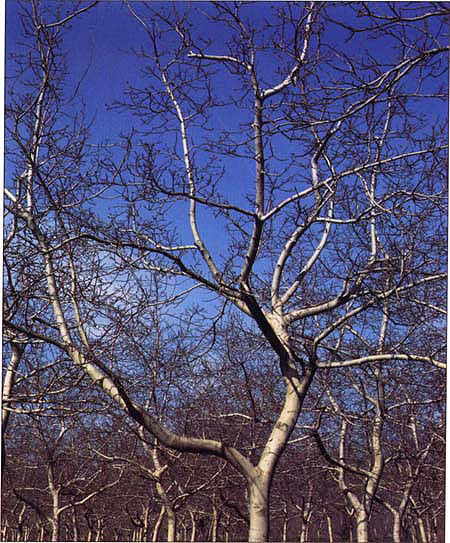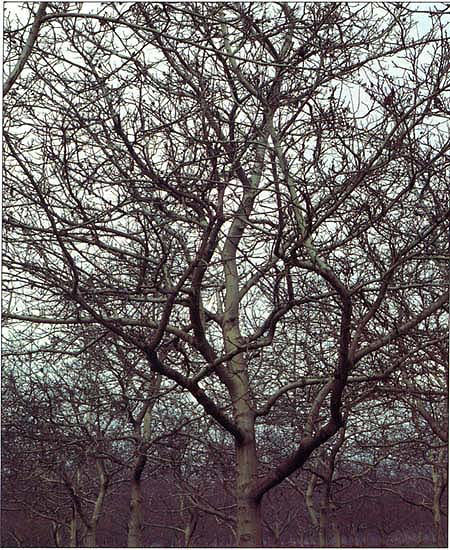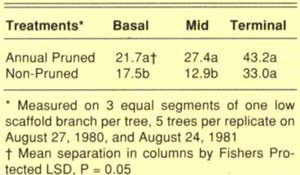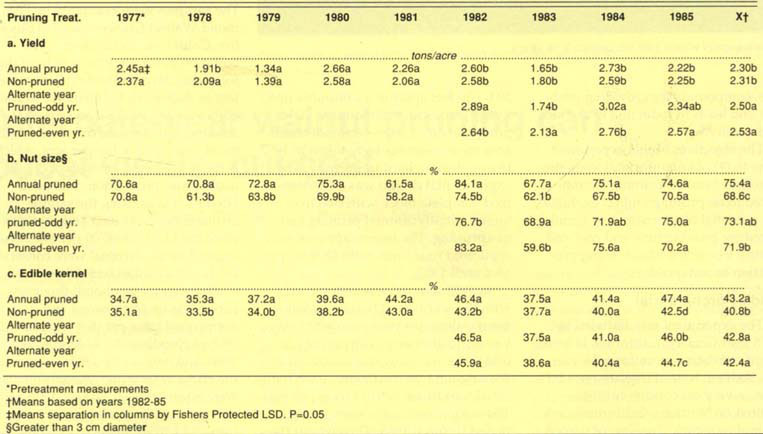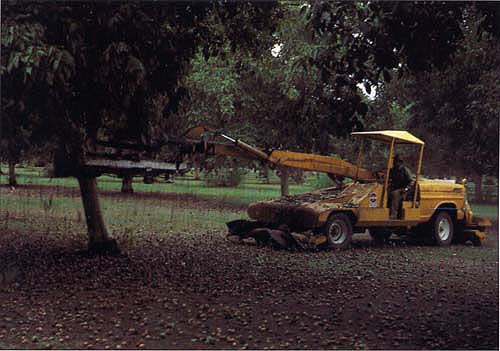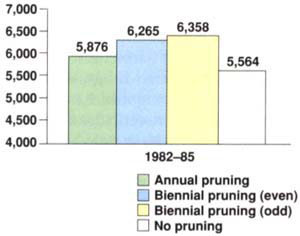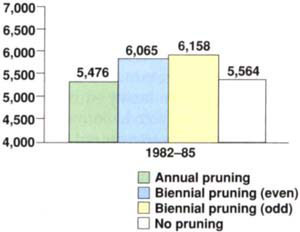All Issues
Alternate-year walnut pruning can boost yields, cut cost
Publication Information
California Agriculture 48(4):20-23.
Published July 01, 1994
PDF | Citation | Permissions
Abstract
Annual pruning was compared to nonpruning for 8 years and to two alternate-year pruning treatments for 4 years in a mature, full-canopied ‘Ashley’ walnut orchard. Pruning increased light penetration and subsequent nut distribution throughout the canopy. Nut size and percent edible kernel wen? consistently lower in nonpruned trees than in trees pruned annually or biennially. However, annual pruning did not improve yield over that of nonpruned trees because fruitful spurs were removed. Alternate-year pruning resulted in yields comparable to those for nonpruned and annually pruned trees in the year following pruning. Biennially pruned trees yielded more than annually or nonpruned trees during the year pruning was not performed. Alternate-year pruning produced the highest income per acre even when the cost of pruning was considered.
Full text
Lateral-bearing English walnut orchards in California are commonly planted at a density of 48 trees per acre. Trained to a modified central leader, the canopy covers the orchard floor within 10 to 12 years. Once crowding occurs, spurs in the lower part of the tree die, resulting in dead branches and an elevated bearing area. This situation leads to poor spray coverage and increased pruning costs.
In crowded orchards, sometimes temporary trees are completely removed. Alternatively, temporary trees can be gradually pruned back over several years before removal to minimize the production loss. Ultimately, only about half of the original tree density remains. Tree thinning in California walnut orchards is not popular because of the uncertainties of regaining production and the threat of fatal tree diseases on the remaining trees.
An alternative to walnut tree removal is intense annual pruning. However, growers question the value of this practice because of the time and equipment involved. The cost is also substantial, ranging from $100 to $250 per acre. No pruning, another alternative, compounds the crowding problem and leads to reduction in nut size and quality.
The objectives of this experiment were to (1) obtain information on the benefits of annual pruning as compared to no pruning and (2) evaluate the potential of alternate-year pruning to reduce pruning time and cost and control tree size without losing production or nut quality.
Gridley orchard trial
The experiment was initiated in 1978 near Gridley, California, in an orchard consisting of uniform 16-year-old ‘Ashley’ walnut (Juglans regia L.) trees, a very precocious cultivar grafted on Northern California black walnut rootstock. Trees were spaced 30 by 30 feet apart in a Columbia fine, sandy loam soil. Pretreatment yield, nut quality and cross-sectional trunk area measurements were taken in 1977 to establish orchard uniformity. The experimental design was a randomized complete block with two treatments initially: annual pruning and nonpruning. The two treatments were replicated four times with 48 trees per plot until 1982.
In 1982 the trial was redesigned with the addition of two new treatments: alternate-year pruning in even years and alternate-year pruning in odd years. The new trial consisted of the original two treatments, each replicated four times with 12 trees per plot. These four treatments were maintained through 1985. Throughout the experiment, guard trees surrounding each plot were pruned similarly to eliminate border effects. Selective limb pruning of all treatments was performed in January and February of each year.
The pruning objectives were (1) to keep trees from interfering with and shading each other, (2) to maintain open tree centers, (3) to control tree height, (4) to replace old, nonvigorous fruitwood and (5) to thin out crowded areas within the trees. These objectives were accomplished by making approximately 37 thinning-type pruning cuts on each pruned tree annually. Most pruned branches ranged from 1.50 to 3.00 inches in diameter. Fresh pruning weights were taken each year on the same 10 trees per replicate through 1981 and on the same three trees per replicate from 1982 through 1985. Pruning was performed by one person using a pruning tower. One acre of trees could be pruned following these objectives in approximately 10 hours.
Each year composite yields from the 48- or 12-tree plots were taken, and six 1-pound walnut samples were taken from each plot for quality analysis until 1982, when the number of samples was reduced to four per plot. The samples were evaluated by Diamond Walnut Growers, Inc., of Stockton, California. Evaluations were based on percentage by weight of the following: large walnuts (>3 centimeters in diameter), light-colored kernel, edible kernel, internal and external damage and offgrade (insect damage, mold, etc.). Nut value per acre, which is the result of a combination of nut quality and production, was calculated each year using the sample evaluations, yield data and average price paid in 1978 ($700 per ton). Pruning and brush disposal were conservatively estimated to be $100 per acre.
Photosynthetic photon flux measurements on five pruned and nonpruned trees per plot were taken on two cloudless days (August 27, 1980, and August 24, 1981) to evaluate the effect of pruning. Measurements were taken between 12:30 and 1 p.m. with a portable Lambda light meter (model LI 185A, made in Lincoln, Nebraska) and Lambda quantum sensor (model LI 191S) 1 meter above the ground on an east-west transect at 0.60-meter intervals through the canopy, starting 0.30 meters from the trunk. The data for the 2 years were averaged and statistically analyzed.
In 1980 and 1981 the percentage of fruitful buds was determined on one low scaffold branch on each of five pruned and nonpruned trees per replicate. Each scaffold branch was partitioned into three equal segments: basal, mid and terminal. Results from each segment were then statistically analyzed.
Pretreatment data on tree size, yield and nut quality indicated high orchard uniformity with no statistical differences.
TABLE 2. Effect of pruning on yield, percent large size nut and percent edible kernel on mature Ashley walnuts
Differences in yield, nut size
Fresh pruning weights from the annually pruned trees indicated that pruning was more intense during the first 2 years than during the remainder of the trial; an average of 81.5 (±26.9) pounds per tree was removed in 1978 and 1979, compared to 41.9 (±15.4) pounds during 1980–85. Pruning weights from the alternate-year treatments averaged 64.0 (±17.2) pounds in odd years and 60.6 (±16.8) pounds in even years.
Although alternate-year pruning weights averaged about 20 pounds more per tree than for annually pruned trees, the per-acre pruning time required was nearly the same. This fact suggests that pruning tower speed contributes more to pruning time than the number of cuts made.
The percentage of fruitful buds on the basal and mid segments of scaffold branches was significantly greater on annually pruned than on nonpruned trees (table 1). There was no significant difference in the percentage of fruitful buds on the terminal segment of the scaffold branches between the two treatments. This distribution of fruitful buds is associated with increased light penetration in pruned versus nonpruned treatments (data not shown).
Yields from nonpruned trees were comparable to those of annually pruned trees for the 8 years of the experiment, with the exception of 1978, when the nonpruned treatment significantly outyielded the annually pruned treatment (table 2a). Yields from alternate-year pruned trees in the growing season following no pruning were significantly greater than yields from other treatments. Average yield for 4 years from alternate-year pruned trees was significantly greater than yield from annually pruned or nonpruned trees (table 2a).
Heavy pruning in the first year of this experiment (1978) reduced yield in the annually pruned treatment as compared to the nonpruned treatment in 1978. Although there was no significant difference in yield between trees pruned annually and nonpruned from 1979 through 1985, the distribution of fruitful buds appears to have been affected (table 1). Most of the nuts on nonpruned trees were located on the peripheral third of the branches, while annually pruned trees frequently had nuts located on the mid and basal thirds of branches.
Percent large size walnuts and percent edible kernel were the only nut quality parameters significantly affected. Pruning promoted larger size nuts in most years. In 3 of 4 years, lack of pruning caused a significant reduction in percent large nuts (table 2b). Overall average nut size was slightly reduced by alternate-year pruning as compared to annual pruning during the experiment. Trees receiving no pruning consistently yielded the smallest nuts.
Percent edible kernel was significantly greater in 5 of the 8 years in annually pruned trees as compared to nonpruned trees (table 2c). The percent edible kernel from alternate-year pruning was comparable to that for annual pruning in 3 of 4 years (table 2c). Nonpruning significantly decreased the average percent edible kernel over the 4 years.
Accumulative gross and net values per acre over the final 4 years of the experiment are shown in figure 1 and Figure 2. Although annually pruned trees had greater nut size and quality than nonpruned, the accumulative increase in value of $312 (fig. 1) was not enough to offset pruning and brush disposal cost of $400 over the 4 years (fig 2). Alternate-year pruning increased production, resulting in an accumulative gross value of $436 more than annual pruning (fig. 1). In addition, the pruning cost for alternate-year pruning was half that of annual pruning since pruning was done only every other year.
Fig. 1. Four-year accumulative gross return in dollars per acre based on $700/ton x crop quality value. Pruning and brush disposal estimated to be $100/acre/year.
Fig. 2. Four-year accumulative net return in dollars per acre based on $700/ton x crop quality value and subtracting cost of pruning and brush disposal estimated to be $100/acre per year.
Best return
It is known that pruning walnuts results in the production of long, vigorous shoots. In lateral-bearing walnut cultivars, these shoots produce many nuts in the second growing season after pruning. This trial indicates that alternate-year pruning takes advantage of this bearing habit by maximizing production in the growing season following nonpruning. It also renews fruitwood without sacrificing production in the growing season following pruning. Although nut quality and value were greater in the annually pruned treatment, alternate-year pruning had a higher net return because of increased production and lower pruning cost. This makes alternate-year pruning of mature lateral-bearing walnut trees an attractive alternative to annual pruning. The practice is also clearly better than nonpruning.
Increasing alternate bearing is always a concern with alternate-year walnut pruning. In this experiment it was observed that pruning biennially following the growing seasons of low production tended to reduce the alternate-bearing tendency, while pruning biennially following the growing seasons of high production tended to accentuate it. Consequently, when considering an alternate-year pruning program, one should consider the cropping history of the walnut orchard. Practically speaking, however, this may be a relatively minor consideration, since many growers may opt to prune half of the orchard each year.



